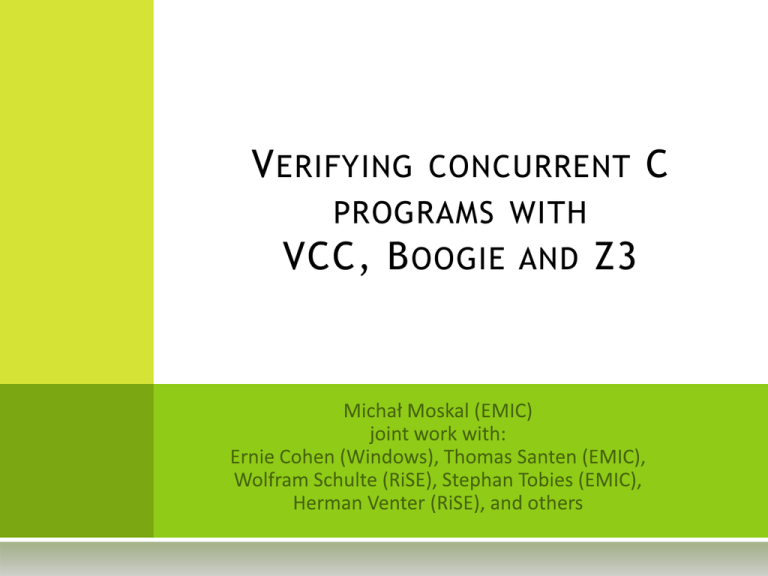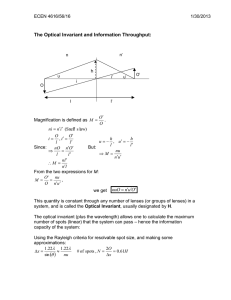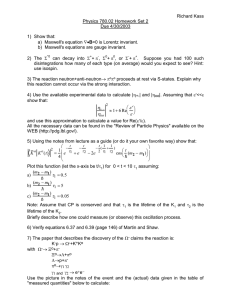Verifying concurrent low-level software with VCC
advertisement

V ERIFYING CONCURRENT C
PROGRAMS WITH
VCC, B OOGIE AND Z3
VCC
Research in Software
Engineering
VCC stands for Verifying C Compiler
developed in cooperation between RiSE group at
MSR Redmond and EMIC
a sound C verifier supporting:
concurrency
ownership
typed memory model
European Microsoft
Innovation Center,
Aachen
VCC translates annotated C code into BoogiePL
Boogie translates BoogiePL into verification conditions
Z3 (SMT solver) solves them or gives couterexamples
H YPERVISOR
current main client:
verification in cooperation between EMIC, MSR
and the Saarland University
kernel of Microsoft Hyper-V platform
60 000 lines of concurrent low-level C code
(and 4 500 lines of assembly)
own concurrency control primitives
complex data structures
VCC
WORKFLOW
Annotate C code
Verify with
VCC
erified
Error
Inspect counterexample
with Model Viewer
Compile with
regular C compiler
Timeout
Executable
Inspect Z3 log
with Z3 Visualizer
Fix code or specs
with VCC VS plugin
O VERVIEW
naive modeling of flat C memory means
annotation and prover overhead
force a typed memory/object model
information hiding, layering, scalability
Spec#-style ownership
+ flexible invariants spanning ownership domains
modular reasoning about concurrency
two-state invariants
PARTIAL
void bar(int *p, int *q)
requires(p != q)
{
*p = 12;
*q = 42;
assert(*p == 12);
}
OVERLAP
void foo(int *p, short *q)
{
*p = 12;
*q = 42;
assert(*p == 12);
}
When modeling memory as array of bytes,
those functions wouldn’t verify.
p
q
VCC-1:
REGIONS
In VCC-1 you needed:
void bar(int *p, int *q)
requires(!overlaps(region(p, 4), region(q, 4)))
{
*p = 12;
*q = 42;
assert(*p == 12);
}
high annotation overhead, esp. in invariants
high prover cost: disjointness proofs is something
the prover does all the time
T YPED
MEMORY
keep a set of disjoint, top-level, typed objects
check typedness at every access
pointers = pairs of memory address and type
state = map from pointers to values
struct A {
int x;
int y;
};
struct B {
struct A a;
int z;
};
a
⟨42, B⟩
x
⟨42, A⟩
⟨42, int⟩
y
⟨46, int⟩
z
⟨50, int⟩
R EINTERPRETATION
memory allocator and unions need to change
type assignment
allow explicit reinterpretation only on top-level
objects
havoc new and old memory locations
possibly say how to compute new value from old
(byte-blasting) [needed for memzero, memcpy]
cost of byte-blasting only at reinterpretation
D ISJOINTNESS WITH
EMBEDDING AND PATH
if you compute field adress
(within a
typed object)
the field is typed
the field is embedded
in the object (unique!)
the only way to get to
that location is through
the field
W RITES
COMMUTE BY
...
int *p, *q;
short *r;
struct A { int x, y; } *a;
struct B { int z; } *b;
a->x
path(...)
a->y
*p
emb(...)
p != q
b->z
*q
*r
type
B ITFIELDS AND FLAT UNIONS
struct X64VirtualAddress {
i64 PageOffset:12; // <0:11>
u64 PtOffset : 9; // <12:20>
u64 PdOffset : 9; // <21:29>
u64 PdptOffset: 9; // <30:38>
u64 Pml4Offset: 9; // <39:47>
u64 SignExtend:16; // <48:64>
};
union X64VirtualAddressU {
X64VirtualAddress Address;
u64 AsUINT64;
};
bitfields axiomatized on integers
select-of-store like axioms
limited interaction with arithmetic
union Register {
struct {
u8 l;
u8 h;
} a;
u16 ax;
u32 eax;
};
T YPED
MEMORY: SUMMARY
forces an object model on top of C
disjointness largely for free
for the annotator
for the prover
at the cost of explicit reinterpretation
more efficient than the region-based model
V ERIFICATION METHODOLOGY
VCC-1 used dynamic frames
nice bare-bone C-like solution, but...
doesn’t scale (esp. when footprints depend on
invariants)
no idea about concurrency
S PEC #- STYLE
open object,
modification allowed
owner link
OWNERSHIP
invariants
depend on
ownership
domain
system invariant:
closed object
invariant holds
+ hierarchical
opening
S EQUENTIAL OBJECT
LIFE - CYCLE
thread-owned
open
mutable
wrap
object can be
modified
unwrap
wrap owner
wrapped
invariant
holds
wrap/unwrap
grand-owner
nested
closed
unwrap owner
P ROBLEMS
for concurrency we need to restrict changes to shared
data
two-state invariants (preserved on closed objects
across steps of the system)
updates on closed objects
but how to check invariants without the hierarchical
opening?
even in sequential case invariants sometimes need to
span natural ownership domains
for example...
S YMBOL
TABLE EXAMPLE
Invariants of syntax tree nodes depend on the symbol table, but they
cannot all own it!
typical for
concurrent
objects
struct SYMBOL_TABLE {
volatile char *names[MAX_SYM];
invariant(forall(uint i; old(names[i]) != NULL ==>
old(names[i]) == names[i]))
};
struct EXPR {
uint id;
SYMBOL_TABLE *s;
invariant(s->names[id] != NULL)
};
But in reality they only depend on the symbol table growing, which is
guaranteed by symbol table’s two-state invariant.
A DMISSIBILITY
An invariant is admissible if updates of other objects (that
maintain their invariants) cannot break it.
The idea:
generate
proof
obligation
check that all invariants are admissible
in separation from verifying code
when updating closed object, check only its
invariant
By admissibility we know that all other invariants are
also preserved
S YSTEM
INVARIANTS
Two-state invariants are OK across system transitions:
Things that you own are closed and have the owner set to you:
S EQUENTIAL
ADMISSIBILITY
An invariant is admissible if updates of other objects (that
maintain their invariants) cannot break it.
non-volatile fields cannot change while the object
is closed (implicitly in all invariants)
if you are closed, objects that you own are closed
(system invariant enforced with hierarchical
opening)
if everything is non-volatile, “changes” preserving
its invariant are not possible and clearly cannot
break your invariant
the Spec# case is covered
H OW CAN EXPRESSION KNOW
THE SYMBOL TABLE IS CLOSED ?
expression cannot own symbol table (which is
the usual way)
expression can own a handle (a ghost object)
handle to the symbol table has an invariant that
the symbol table is closed
the symbol table maintains a set of outstanding
handles and doesn’t open without emptying it
first
which makes the invariant of handle admissible
H ANDLES
struct Handle {
obj_t obj;
invariant(obj->handles[this] && closed(obj))
};
struct Data {
bool handles[Handle*];
invariant(forall(Handle *h; closed(h) ==>
(handles[h] <==> h->obj == this)))
invariant(old(closed(this)) && !closed(this) ==>
!exists(Handle *h; handles[h]))
invariant(is_thread(owner(this)) ||
old(handles) == handles ||
inv2(owner(this)))
};
C LAIMS
inline, built-in, generalized handle
can claim (prevent from opening) zero or more objects
can state additional property, much like an invariant
subject to standard admissibility check (with added
assumption that claimed objects are closed)
checked initially when the claim is created
allow for combining of invariants
everything is an object! even formulas.
L OCK - FREE
ALGORITHMS
Verified locks,
rundowns,
concurrent stacks,
sequential lists...
struct LOCK {
volatile int locked;
spec( obj_t obj; )
invariant( locked == 0 ==> obj->owner == this )
};
havoc to simulate
other threads;
assume invariant
of (closed!) lock
check two-state
invariant of
objects modified
int TryAcquire(LOCK *l spec(claim_t c))
requires(wrapped(c) && claims(c, closed(l)))
ensures(result == 0 ==> wrapped(l->obj))
{
pass claim to make sure
int res, *ptr = &l->locked;
the lock stays closed (valid)
atomic(l, c) {
res = InterlockedCmpXchg(ptr, 0, 1);
// inline: res = *ptr; if (res == 0) *ptr = 1;
if (res) l->obj->owner = me;
}
return res;
}
H EAP
PARTITIONING
threads are also
considered objects
thread
“owns” is inverse of the
owner link and can be
marked “volatile”
Heap partitioned into:
owns
owns
owns
x
baz1
y
volatile
non-volatile
baz2
owns
owns
owns
foo
x
next
bar
y
owns
owns
next
baz
owns
owns
next
foo
ownership
domains of
threads
shared state
C ONCURRENT MEETS
SEQUENTIAL
operations on thread-local state only performed
by and visible to that thread
operations on shared state only in
atomic(...){...} blocks
effects of other threads simulated only at the
beginning of such block
their actions can be squeezed there because they
cannot see our thread-local state and vice versa
otherwise, Spec#-style sequential reasoning
S EQUENTIAL
also for
claims!
FRAMING
thread
explicitly
in domain
writes
possibly
modified
havoc
W HAT ’ S
LEFT TO DO ?
superposition – injecting ghost code around an atomic
operation performed by a function that you call
we only went that low
address manager/hardware <=> flat memory
thread schedules <=> logical VCC threads
annotation overhead
performance!
VC splitting, distribution
axiomatization fine tuning, maybe decision procedures
T HE
questions?
END


